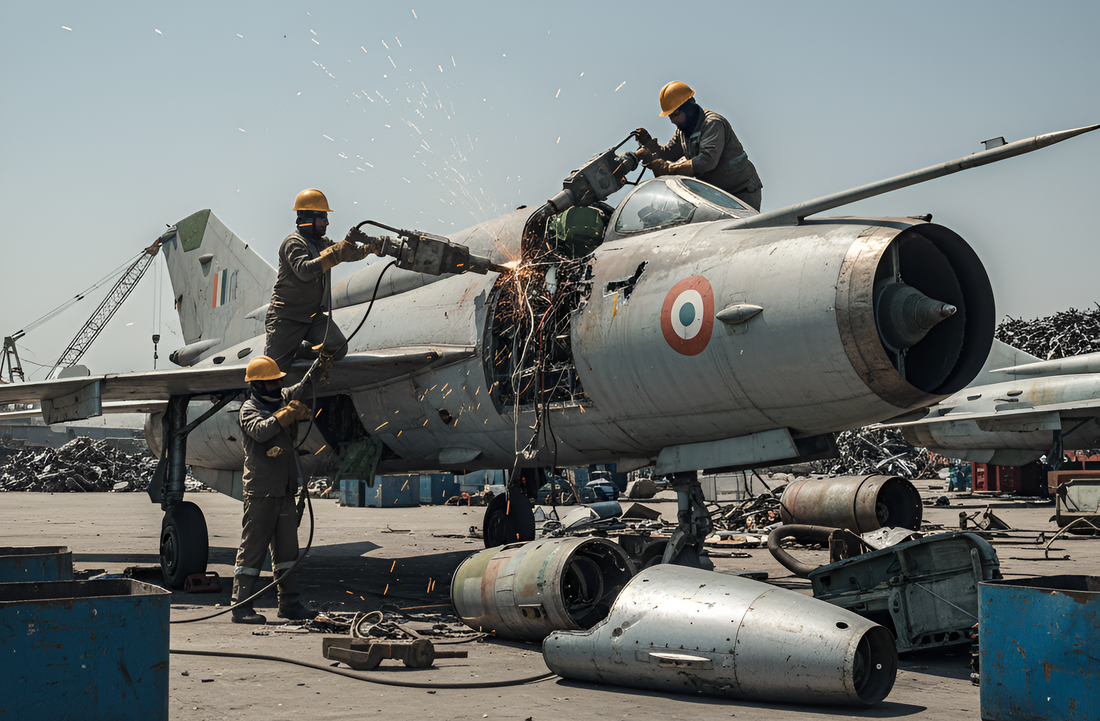What Will Happen to MiG-21 Fighter Jets After Retirement?

The retirement of the MiG-21 fighter jets by the Indian Air Force on September 26, 2025, signifies not just the end of a storied chapter in military aviation but also a pivotal moment in India's defence evolution. Introduced in 1963 as India's first supersonic fighter, the MiG-21 quickly became the backbone of the IAF, with over 870 units procured to enhance combat readiness.
Its contributions spanned multiple conflicts: during the 1965 Indo-Pak War, it provided essential air defence; in the 1971 war, it was instrumental in achieving air superiority, with veterans attributing up to 80% of the IAF's success to its performance; in the 1999 Kargil Conflict under Operation Safed Sagar, upgraded variants executed high-altitude bombing missions; and in 2019's Balakot airstrike, a MiG-21 Bison famously engaged a Pakistani F-16, piloted by Wing Commander Abhinandan Varthaman.

Beyond combat, it served as a vital training platform, influencing generations of pilots and shaping tactical doctrines. However, its legacy is mixed, marred by a high accident rate over 480 incidents from 1971 to 2012 earning it the moniker "Flying Coffin" and accelerating calls for retirement amid safety concerns.
The farewell event at Chandigarh Air Force Station was a grand affair, featuring the jet's final operational sortie as part of Operation Sindoor, a ceremonial water cannon salute, and remarks from Defence Minister Rajnath Singh, who hailed it as a symbol of courage and innovation. This retirement reduces the IAF's squadron count to 29, against an authorized 42, underscoring the urgency for fleet modernization.

The Light Combat Aircraft Tejas, particularly the Mk1A variant, emerges as the direct successor, with indigenous development aligning with India's Atmanirbhar Bharat initiative. Future plans include the Advanced Medium Combat Aircraft (AMCA), a fifth-generation stealth fighter, to position India among global defence leaders, though procurement delays have historically prolonged the MiG-21's service life.

Regarding the fate of these retired jets, military protocols typically involve a thorough assessment post-decommissioning to decide their next phase. One primary option is preservation in museums or as public displays, which serves educational and inspirational purposes. For instance, the Air Force Museum in Delhi's Palam is likely to feature a MiG-21 soon, joining other vintage aircraft to commemorate its history.
Internationally, museums may also acquire units, drawing parallels to exhibits like the Soviet-era TU-142M turned into a beachside museum in Visakhapatnam. Some reports suggest a few MiG-21s, possibly the upgraded Bison versions, could be kept airworthy for a ceremonial vintage squadron, allowing occasional flights for heritage events.
Another common path is dismantling and scrapping, where valuable components such as radars, sensors, electronic warfare systems, and cockpit electronics are salvaged for use in active fleets or sold. The airframe is then broken down and recycled as scrap metal, a cost-effective measure seen in cases like the Indian Navy's INS Vikrant, auctioned for Rs 60 crore in 2014. While not explicitly confirmed for these MiG-21s, this remains a practical option given the fleet's age.
Retired aircraft can also be repurposed for training, including as ground-based instructional tools or expendable aerial targets for live-fire exercises, a practice rooted in World War I and applied to jets like the US F-4 Phantom and F-16. In rare cases, they enter private collections, as exemplified by French collector Michel Pont's assemblage of fighters, though sales are heavily regulated to prevent technology leaks U.S. models like the F-22 are barred from foreign buyers.
Comparatively, global practices vary: the U.S. maintains the "Boneyard" at Davis-Monthan Air Force Base, where aircraft are stored in a desert environment to minimize corrosion, with procedures like fuel draining, tire covering, and white painting for preservation. B-52 bombers there comply with arms treaties by being stored wingless for satellite verification. While India lacks a direct equivalent, similar storage or repurposing logic applies.
To illustrate the range of possibilities, the following table summarizes potential outcomes for retired MiG-21 jets, based on reported practices:
| Fate Option | Description | Examples/Notes |
|---|---|---|
| Museum Displays | Preserved as static exhibits for public viewing and education. | Likely placement in IAF Museum, Delhi; similar to TU-142M in Visakhapatnam. |
| Vintage Squadron | Maintained in flying condition for ceremonial or heritage flights. | Possible for Bison variants; unconfirmed but speculated in reports. |
| Dismantling/Scrapping | Stripped for parts and recycled as scrap. | Common for aged fleets; parallels with decommissioned naval vessels. |
| Training Aids | Used for ground instruction or as aerial targets in exercises. | Historical use in target practice; seen in U.S. retired jets like F-16. |
| Private Collection | Sold to collectors with restrictions on sensitive parts. | Rare; examples include private ownership of Meteor or F-16 fighters. |
This table highlights the multifaceted approaches, prioritizing utility and legacy preservation over outright disposal. While specifics for the September 2025 retirees may evolve potentially influenced by IAF announcements or international interest the emphasis appears to lean toward honoring the MiG-21's contributions through visible tributes rather than complete obsolescence.
As India advances its air force with modern assets, the MiG-21's transition from active duty to retirement exemplifies the balance between nostalgia and progress in military aviation.




















1 comment
Fail to understand d what 60s technology can be used by someone,when the future wars would be fought by the drones and modern fighter aircrafts are fly by wire.
Dont we sell military vehicles and eaier even NSP weapons were being sold.
How could u decide not to dispose off 800 odd Migs with the IAF.Surely all of them can’t be gifted for display at the Educational Insts, as getting a free gift is alright,but who looks after their display care after that.They become shifting place for the birds and cost a fortune to re-paint at regular intervals.
Best is to dismantle them,retrieve serviceable parts for use in other similar aircraft( doubtful if these parts can be calibrated in next generation aviation machines).
Surely one odd should be kept for display vintage flights on ceremonial occasions like the AF Day and Aero shows.
The Museum of TU 124 at Vizag is certainly worth it,but a toy sized Mig is fit for only AF Museum at Palam.
While commanding a Nat Climbing School at J&K,after running around,got okay for a frame for display at JIM,but the AF wanted the cost of transportation from Delhi to Kashmir to be borne by the Inst(sic).
Thought Modi wanted a tank to be put at the JNU ( for reasons,not to be expressed),we would also be given it free.